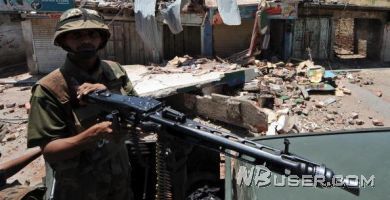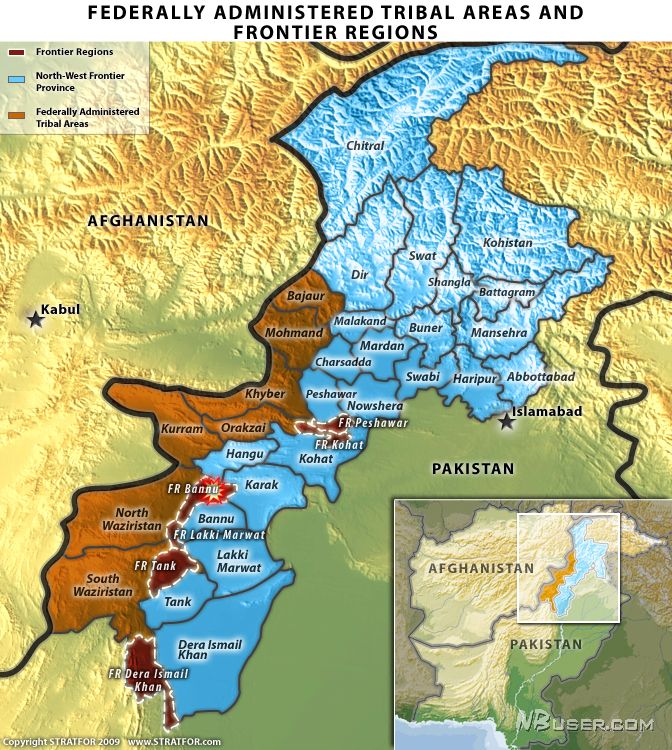

Summary
The Pakistani military is attempting to finish its counteroffensive in the Swat Valley against the jihadists and realize they must move quickly from Swat to Waziristan to crush the jihadist threat. The army is off to a rocky start in its conflicts with the local tribes, which underscores the difficulties that the army faces in its attept to reclaim Waziristan. The ongoing efforts will bear considerable scrutiny as the military attempts to adapt what it learned from the Swat campaign and tailor its efforts to the local political and tribal landscape.
Analysis
Pakistani military forces are still trying to clear the Swat region of Pashtun jihadists, and have engaged in heavy fighting with Taliban militants over the past few days on a new front on the southern border between the North-West Frontier Province (NWFP) and the Federally Administered Tribal Areas (FATA). Attack helicopters and artillery have been used to strike in the Janikhel and Bakakhel areas of Frontier Region (FR) Bannu, where 100 militants, including a key commander, Sher Alam, have reportedly been killed. As many as 800 Taliban fighters are believed to have arrived in the area from Razmak and Miramshah in North Waziristan to fight Pakistani troops. This development follows the limited attacks by the Pakistani army in the nearby South Waziristan region — the main hub of the jihadist insurgency raging in the country.
The army action in FR Bannu is likely a key initial part of the preparations for a major offensive in Waziristan. Such action is a tremendous challenge to pull off, considering the weak capabilities of the state and the logistical difficulties on the ground. Islamabad realizes that it cannot afford to allow Pashtun jihadists and their domestic and foreign allies to continue to use Waziristan as a staging area to strike at the very core of the country and undermine the counterjihadist offensive. Therefore, Pakistan has begun to make preparations toward an assault on the jihadist sanctuary in Waziristan, which will likely develop slowly.
Pakistan’s government said several weeks ago that it would expand its counterjihadist offensive from Swat to Waziristan. While the Swat-based Taliban group has focused on consolidating their emirate in the areas of the old Malakand division, the Tehrik-i-Taliban Pakistan (TTP) led by Baitullah Mehsud, headquartered in South Waziristan has teamed with Punjabi Islamist militants to stage high profile commando-style suicide bombings, especially in major urban cities in the province of Punjab. The June 9 attack on the largest 5-star hotel in the NWFP’s capital, Peshawar, is the latest attack and comes in response to the country’s largest counterjihadist offensive in the greater Swat region.
The Mehsud-led Pakistani Taliban leadership, along with their transnational al-Qaeda allies, want to be able to keep Pakistan’s security forces off balance and thus prevent them from expanding the offensive beyond Swat. Conversely, the Pakistanis realize that if they are going to get ahead of the curve in their war against jihadism, they have to move from Swat to Waziristan — and quickly. That said, the government and the army know all too well the great risks to expanding the offensive, given the dire economic situation in the country, critical weakness in the intelligence apparatus, lack of counterinsurgency capabilities to effectively fight an “industrial-strength insurgency” and most importantly, the millions of displaced people amid limited public support.
While Pakistan’s civil and military leadership understands the importance of hitting the nerve center of the Pashtun jihadists — and they have seen a certain degree of success in the northern rim of the tribal badlands in the agencies of Bajaur, Mohmand, and Khyber — Pakistani forces are spread thin in the more crucial southern rim, particularly the Waziristan region. It should be noted that the Pakistani army went into the autonomous FATA (in the South Waziristan region) for the first time since the creation of the region in the spring of 2004, under U.S. pressure in the wake of the jihadist war.
Since then, the offensives that the army has conducted were unsuccessful because of the inability of the security forces to dislodge the militants. Consequently, the army had to withdraw after making ill-fated peace deals, which only facilitated the rise of Mehsud and his TTP. Furthermore, the NWFP districts that run along the two Waziristans, North and South, fell to Taliban influence in the last five years, which overwhelmed local law enforcement agencies. Essentially, this means that in order to mount a serious offensive, the army has to essentially redeploy around the Waziristan region from scratch, and the fighting in FR Bannu is part of this strategy.


The fighting in the Janikhel and Bakakhel tribal areas in FR Bannu began after the abduction of several hundred people from nearby Razmak Cadet College last week. The kidnapped people were released but security forces demanded that local tribes hand over people believed to be involved in the incident. More importantly, the Pakistani army wanted to replace the local Khasadar security forces operating British-era security outposts with regular army troops, which was fiercely opposed by the tribes who want to maintain the practice of the Khasadars working with the tribes to ensure security in the area.
The resistance put up by the tribes led to the army using force, which is an unusual development. The Pakistanis have avoided the alienation of the tribes in order to prevent the Pashtuns from turning into Talibs. In fact, the Pakistanis need the tribes to help them develop anti-Taliban militias. That the army decided to take action against the tribes in FR Bannu is an indicator that the Pakistanis are willing to incur a certain degree of social risk to try and go after the Waziristan-based Taliban. Besides, such militias in areas like the northern part of Dir in the NWFP are playing a critical role to help the Pakistani army flush out the jihadists; the FATA is a different story.
The system of tribal maliks in the autonomous tribal areas has been severely undermined by the mullahs or commanders of the Taliban or both. In addition, the Taliban have exploited the deeply conservative culture and tribal desire of autonomy as a means to incite revolt against the state, especially its army, which is further exacerbated by the dozens of U.S. unmanned aerial vehicle (UAV) strikes that have occurred in the area. Therefore, those tribal maliks that still possess some authority are likely to oppose the army, if for nothing else than to avoid getting caught up in the war between Islamabad and the Taliban, which is what is currently taking place in FR Bannu.
While the FATA is virtually open stomping grounds for the Taliban, the situation in the FRs — six small administrative enclaves on the border between FATA and the adjacent NWFP districts — is more complex. The semi-tribal FRs are physically located inside the FATA agencies — FR Dera Ismail Khan and FR Tank in South Waziristan, FR Lakki Marwat split between North and South Waziristan, FR Bannu in North Waziristan, and FR Kohat and Peshawar in Orakzai. Administratively, however, they have been kept distinct from the FATA agencies, a complex arrangement that worked well for the Pakistani state for some five decades until the U.S.-jihadist War.
These areas are on the eastern ends of the tribal agencies bordering the settled districts of the NWFP with whom they share their names. This is why the tribal leaders in the FRs are likely to have greater influence than their counterparts, who are located deeper into the agencies of FATA and closer to the border with Afghanistan — areas under the control of the Taliban. The government is likely trying to use this situation to its advantage in order to come in and set up shop. A key goal is to establish supply lines in these parts, which would otherwise be long and run through areas that are hostile or autonomous or both. The lengthy alternatives ran between the Waziristan region and the XIth Corps based in Peshawar and the other garrisons in the NWFP.
FR Bannu, FR Lakki Marwat, FR Tank and FR D.I. Khan are the natural staging grounds from any sustained campaigns against the de facto Taliban emirate headquartered in the Waziristan region. But fighting with the tribes in the FR Bannu region clearly shows that the army is off to a rocky start, which underscores the major challenges that the army faces in its efforts to take back Waziristan.
Waziristan will be more difficult than Swat because it is far more remote. Swat had a certain degree of state infrastructure (albeit very thin) because it was formally incorporated into the NWFP. But Islamabad has virtually no presence in Waziristan because of its historical autonomous status dating back to British rule. The autonomous status worked well, so long as there was no challenge from transnational jihadist forces.
The ongoing efforts will bear considerable scrutiny as the military attempts to adapt what it learned from the Swat campaign and tailor its efforts to the local political and tribal landscape. Indeed, early efforts may also be attempts to validate certain tactics and operational principals intended for the wider Waziristan campaign, and to apply lessons learned from the offensive in Swat.